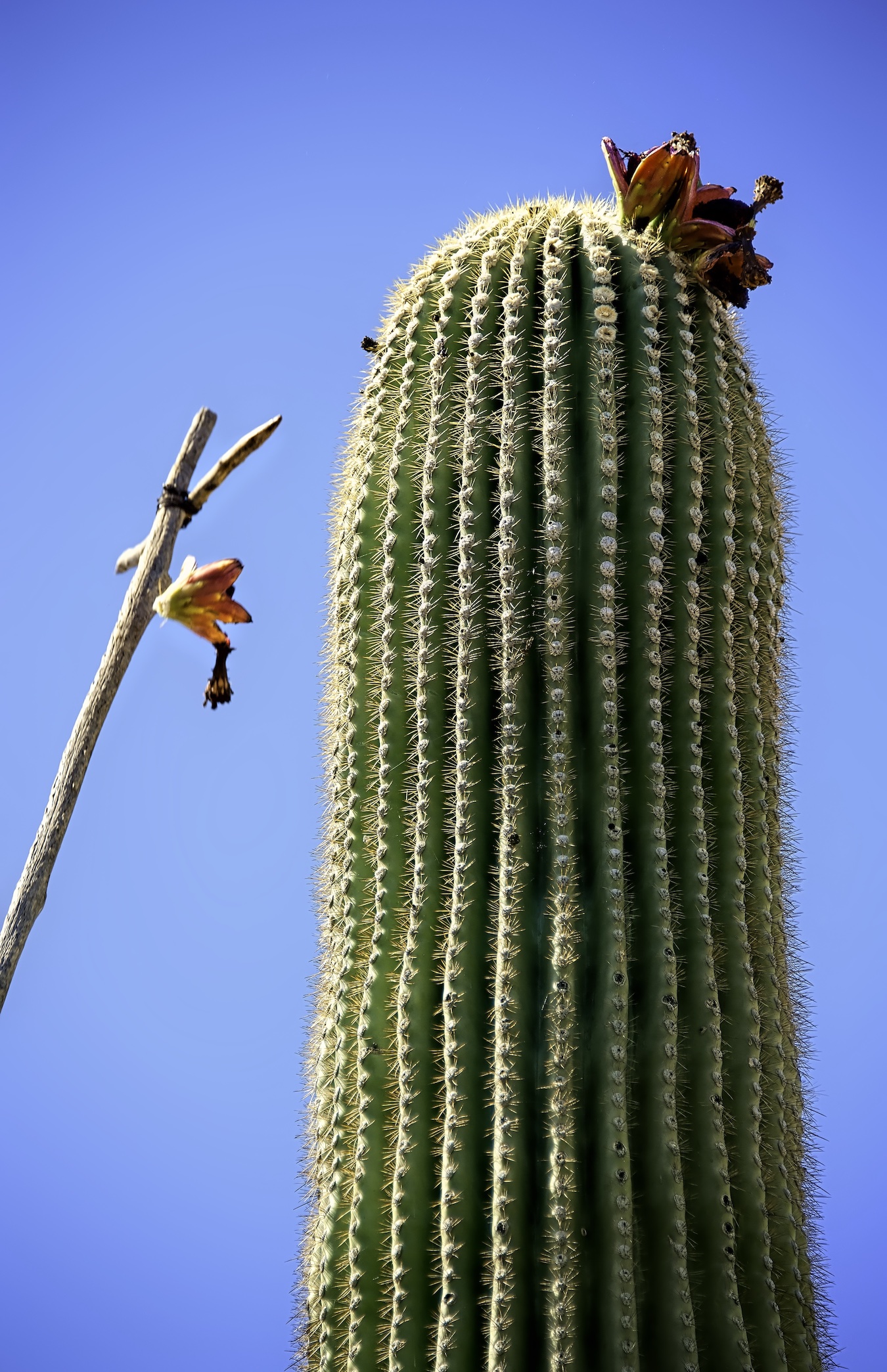By Rebecca L. Rhoades
At 7 a.m. on an early summer day, the sun already is beating down oppressively on a flat patch of arid land in Southern Arizona. In the dappled shadow of a palo verde tree, brother and sister Dallas and Lynn Liston prepare to welcome the day’s harvest. The rhythmic cadence of a gourd rattle breaks the silence, and the siblings begin to sing.
The melodic tune, sung in the Listons’ native Tohono O’odham language, is a traditional blessing that asks for good harvests and rain — and that gives thanks to the Southwest’s iconic saguaro cactus that brought them to the national park that bears its name.
The Tohono O’odham people have lived in the Sonoran Desert for thousands of years, and they have harvested the saguaro’s fruit, known collectively in O’odham as “bahidaj,” for much of that time.
“We harvest a lot of things from the desert that we use for basketry and for food,” Dallas says. “In all aspects, where we get our food from is important to us, but this is a bit more special. Prickly pears grow everywhere. But the “bahidaj” is only in certain areas, and the harvest time is just a small window.”
This harvest is not done just for sustenance. The Tohono O’odham rely on it to usher in the monsoon season. It also marks the tribe’s new year. While the undertaking is not as common as it used to be, the act of picking saguaro fruit and the harvest ceremonies remain central to the tribe’s culture.
Encompassing more than 90,000 acres split between two districts that flank the city of Tucson, Saguaro National Park has the largest concentration of saguaros (Carnegiea gigantea) in the world, according to Jesús García, an education specialist at Arizona-Sonora Desert Museum, which offers public workshops on how to harvest saguaro fruit. Endemic only to the Sonoran Desert and parts of northern Mexico, the plants thrive on rocky slopes with southern exposure and in hot, dry climates that receive between three and 15 inches of rain annually.
A staple of Western movies and imprinted on generations that grew up watching the exploits of Wile E. Coyote and the Road Runner, saguaros are one of the world’s most recognized cacti. The quirky green giants tower over the surrounding ecosystem, projecting a distinctive anthropomorphic form thanks to their expressive arms that extend outward in Seussian shapes. They’re also federally protected, and killing, damaging or removing saguaros from the park, or any public land, can result in a hefty fine and even jail time.
For the Tohono O’odham, saguaros are more than a source of food. The stately columns, known as “ha:san,” (pronounced “hashan”) are believed to possess human spirits. “There are stories in our tradition that talk about how the ha:san are people,” Lynn says. “So we respect them as such, and we don’t want to harm them in any way. Because of that, they give us fruit and produce things to help sustain us in the desert.”
Each June, as temperatures soar as high as 115 degrees, O’odham families gather as they have for centuries in the park and on their nearby tribal lands to pick the fruit. They return to the same areas each year and will camp out for a week or longer, gathering fruit, feasting, and connecting with extended family members. Lynn notes that during the pandemic, many families harvested fruit in the park because they could not return to their homes near the Mexican border. They stayed in ancestral “wattos,” or ramadas, that have survived generations to protect them from the blistering sun.

“A key ingredient to the bahidaj is dry heat. The hotter it is, the more the harvest will come,” Dallas explains. “When it’s really hot, we know we’re going to have a plentiful harvest.”
To collect the fruit, which typically grow at the top of the saguaros, sometimes as high up as 15 feet, the O’odham use long picking sticks called “kuipad,” which are fashioned from saguaro ribs (“vapai”) and greasewood or creosote bush (“segai”). The segai crossmember is attached at an angle to the vapai with baling wire.
“There’s so much symbolism in the things that we do,” Lynn says. “We use creosote for the crossbar because it is symbolic of the rain we want to bring.” Anyone who has spent time in the Sonoran Desert during a monsoon season is familiar with the earthy aroma that perfumes the air following a rainstorm. “The creosote makes the desert fragrant,” Lynn adds.
“When we use the kuipad, when we’re pulling down the fruit, we say we’re pulling down the clouds,” she continues. “The whole process is a reflection from the earth to the sky. We pull the clouds, and then down comes the rain.”
Harvesting is done in pairs. One person uses the kuipad to hook and pull down the fruit; the other catches the fruit in a container. “Our ancestors would use baskets or pottery to collect the bahidaj,” Dallas says. Today, the most common vessels are five-gallon plastic buckets.
The first fruit to be picked is used as part of a blessing. In addition to their traditional Native beliefs, Catholicism is a primary influence on the Tohono O’odham, the result of Spanish explorers who arrived in their lands in the late 1600s. Lynn and Dallas rub the pulp of their first fruit on their shirts, directly over their hearts. The empty husk is placed on the ground facing upward, calling to the rain.

Each saguaro can produce as many as 150 fruits. The ruby red pods, about three inches in length, mature in late June and early July. When ripe, they split open, revealing a fibrous pulp full of thousands of tiny black seeds.
“Not all saguaro fruit taste the same, depending on the different stages,” Garcia explains. As the fruit ages and darkens, it becomes sweeter. The taste is mild, not tart, like a fig. “When they’re completely caramelized and dried up, they’re at their sweetest,” he notes. Formic acid from ants that eat the fruit can result in sour notes, while rain can bring about fermentation and cause a tangy flavor.
Traditionally, women process the fruit, but the entire family partakes in the harvest. The Listons recall harvesting fruit in the park as children. “We all came together — aunts, uncles, cousins, grandparents. We would have a huge camp, and we would celebrate,” Lynn remembers. “Villages would come together and dance and pray for the rain.
“Now we gather together as a family,” she continues. “We sing the rain song, we dance, we toast the new year. After the fruit is gathered, when it’s still fresh and in the bucket, we add water to it and make a punch.”
Afterward, the fruit is processed into syrup, jam, or wine. Eight gallons of fruit produce about 30 ounces of syrup. According to Lynn, the syrup often is used on pancakes and ice cream and even in smoothies. The seeds, which are separated from the pulp, are ground into a meal that is used to make porridge or bread or added whole to salads for some extra crunch.
Preserving this ancient tradition is important for the Liston siblings, as well as the Tohono O’odham nation as a whole. “Our elders would say that if nobody goes out to pick the bahidaj, there is not going to be any more,” Lynn says. “The ha:san give of themselves in order to ground us and bring us together. In a way, it’s like how a mother will give her all for her children.”
She continues, “In one of our stories, there is a little girl who turned into the ha:san because she was neglected. The harvest is her saying, ‘Come see me, come take my fruit.’ And because we don’t want our children to be neglected, because we don’t want our desert to be neglected, we come out and pay our respect. The sounds of our children picking and laughing and talking to each other reverberates in the ha:san.”
Today, organizations such as Arizona-Sonora Desert Museum and the International Sonoran Desert Alliance in Ajo help spread knowledge of the harvest to non-Native residents and visitors. Non-members of the Tohono O’odham nation can only participate in the harvest in Saguaro National Park if they are with a tribal member, although if they have saguaros in their own yards, they are allowed to pick any fruit those cacti produce.
For the Listons, it’s important to educate the public about their traditions. “Our mom and grandma encouraged us to share, to get out there and become educators,” Dallas says. “This land is giving, but it can also take away. So we need to become informed about the land and to have respect for it.”
For more information, visit desertmuseum.org or isdanet.org.
Read more Savor articles on Green Living.






